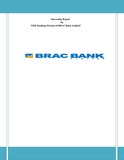| dc.contributor.advisor | Hafiz, Nusrat | |
| dc.contributor.author | Shahriar, Golam | |
| dc.date.accessioned | 2015-10-05T09:26:45Z | |
| dc.date.available | 2015-10-05T09:26:45Z | |
| dc.date.copyright | 2015 | |
| dc.date.issued | 2015-08 | |
| dc.identifier.other | ID 11104067 | |
| dc.identifier.uri | http://hdl.handle.net/10361/4462 | |
| dc.description | This internship report is submitted in a partial fulfillment of the requirements for the degree of Bachelor of Business Administration, 2015. | en_US |
| dc.description | Cataloged from PDF version of Internship report. | |
| dc.description | Includes bibliographical references (page 32). | |
| dc.description.abstract | Small and Medium Enterprises (SMEs) can help to cut poverty to a satisfactory level by
eliminating various prejudices against labor intensive industry and creating jobs for the skilled
manpower in the SME sector. However, the access to financing is still recognized as the leading
obstacle to SME growth in Bangladesh, alike most other developing and under-developed
countries. Small and medium entrepreneurship have a tremendous potential in empowering
potential entrepreneurs and transforming society. To target this sector with huge potentiality
BRAC Bank Ltd introduced SME Banking Division in 2001.
Being the fastest growing bank of the country currently BRAC Bank is operating all over the
country having 157 Branches and Krishi Branches, 22 SME Sales and Service Centers, 300+
ATMs, 405 SME Unit offices. This fastest growing bank works on 3P- People, Planet and Profit;
ensures sustainable growth and largely focuses on SME financing sector.
BRAC Bank SME division was set up to capture “Missing Middle” and to create socio-economic
impact in the country. Within 11 years of establishing it has proved its success through becoming
country’s largest SME finance provider and 4th large SME provider in the world in terms of
lending volume.
For the inheriting business risk, SME sector is facing several constrains in terms of growth.
Policy level complexity, financial constraints, legal bindings and industry structure are hindering
financial institutions to support SME sector. Lack of SME supporters, poor infrastructure of the
country, lack of entrepreneur’s skills, lender-borrower gap, huge market competitions are the
major drawbacks for both borrowers and lenders. Again SME sector has tremendously
contributed in the economy. Today it has been considered as the engine of country’s economy.
Being country’s largest SME provider, BRAC Bank is facing several challenges which are
identified in analytical part of the report. Business risk, high interest rate, high defaulter rate,
certain government policy change etc are the major challenges facing by BRAC Bank. At the
same time BRAC Bank has a large number of defaulters. Even though strict loan approval
system is maintained, due to some unavoidable reason “bad-losses” sometimes occur. In order to
reduce credit risk BRAC Bank follows consistent monitoring system upon borrower’s activities.
Again if someone turns in to defaulter special wing called SAM works to enforce law. | en_US |
| dc.description.statementofresponsibility | Golam Shahriar | |
| dc.format.extent | 32 pages. | |
| dc.language.iso | en | en_US |
| dc.publisher | BRAC University | en_US |
| dc.rights | BRAC University Internship reports are protected by copyright. They may be viewed from this source for any purpose, but reproduction or distribution in any format is prohibited without written permission. | |
| dc.subject | Business administration | en_US |
| dc.subject | Risk management | en_US |
| dc.subject | BRAC Bank | en_US |
| dc.title | Reducing the Risk of Bad debts of “BRAC Bank Limited” | en_US |
| dc.type | Internship report | en_US |
| dc.contributor.department | BRAC Business School, BRAC University | |
| dc.description.degree | B. Business Administration | |

